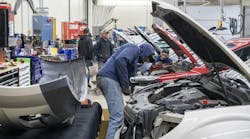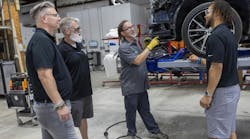YOU BE THE JUDGE
In the world of collision repair, exposure to harmful chemicals is nothing new to most of us. But even though we know the dangers, not all of us know the required safety precautions we must take to protect employees, shop visitors and ourselves. In fact, as I visit shops in North America and abroad, I'm shocked at what is not being done to protect workers from well-known health hazards.
Small businesses make a bad habit of taking short-term risks that they do not even consider for their future. Keep in mind there probably is not a statute of limitations for claims related to health issues, which were caused from an unsafe working environment at a past employer. Think about claims related to asbestos. Attorneys have made careers on such cases and down the road our industry might be faced with similar claims. Additives, such as diisocyanates, can cause serious or fatal respiratory disease and are the leading cause of occupational asthma.There are many different products and procedures that expose employees to health risks. It is an employer's responsibility to make staff members aware of these risks, educate and train them on how to minimize these risks, and provide proper safety equipment. In fact, employers should document safety training and education programs for employees, and workers should sign forms verifying that they have participated in such programs. This process is required yearly and when new products or possible health risks are introduced into the work environment.
One area that requires safety precautions and training is with respirators and fresh air breathing units.
What's required?
Among the early forerunners of the respirator was a device invented in 1847 by Lewis P. Haslett of Louisville, Ky. It allowed breathing through a nose or mouthpiece fitted with two one-way clapper valves; one to permit the inhalation of air through a bulb-shaped filter, and the other to vent exhaled air directly into the atmosphere. Similar use of these valves became common in later masks. The filter material used at the time was wool or some other porous substance moistened with water. It was suited to keeping out dust or other solid particulates, but would not have been effective against poison gases or fumes. In 1849, Haslett's Lung Protector was granted the first U.S. patent for an air-purifying respirator.There are many different options for respirators that are all based in knowing the type of exposure to health hazards of the operation being performed. Also, only properly trained employees physically able to perform the work and wearing the respirator should be assigned a task that requires the use of a respirator. It is the responsibility of the employee to use the proper equipment while performing tasks that present health and safety risks. The Occupational Safety and Health Administration (OSHA) outlines these requirements in rule 1910.0134.
One of the most common respirators seen in shops today is an activated charcoal cartridge. These types of personal protection equipment (PPE) are designed to filter out exposure to chemical fumes when breathing. The system uses specifically designed cartridges for specific exposure types. The intent of this article is not to bash this type of PPE, but to allow everyone to understand that this system only provides minimal protection. It is not recommended to sufficiently protect a technician during spraying operations that include content of isocyanides.
In the first place, the facial features of each individual differ so widely that just getting proper fit is a major challenge. Keep in mind, improper fit equals little to no protection. This is why fit testing is required yearly for any tight fitting respirator, or if the facial features of an individual change (such as through weight gain or loss, or the growth of facial hair). If a consistent, proper fit cannot be achieved, this system should not be used for any application. The process of properly fit testing is not just placing the respirator on and holding your hands over the cartridges and attempting to inhale, or just blocking the exhaust valve and attempting to exhale. It requires a specifically designed test kit.Again, all this is required to be documented and available for immediate inspection. The Inter-Industry Conference on Auto Collision Repair (I-CAR) has an excellent program called Hazardous Materials, Personal Safety and Refinish Safety (WKR01) that outlines many of these requirements and procedures. Keep in mind that just taking the I-CAR course does not meet the full requirements for each employer in regards to the required training under the "Right to Know" regulations in the United States. You also can get a free copy of the Federal EPA Document on Respiratory Protection Program Guidelines by going to The BOSs (www.TheBOSs-Online.com) This document is a comprehensive guide for implementing the proper program. You can register as a free 30-day guest, and once logged in use "Safety" in the document keyword search to examine or download this guide.
Powered air purifying respirators
These units force filtered air to the user rather than requiring the user to breathe through the filters to get filtered air. This creates a positive air flow and reduces the risk of exposure due to a poor tightness of fit on standard cartridge respirators.
There is some uncertainty as to whether these systems are effective for our industry, since they also just filter air. Most of the concerns focus on isocyanides. Specifically, at what level do they no longer meet the regulations for isocyanides exposure limits? Some data indicates that today's well-maintained and operational positive-pressured spray booths remove a sufficient amount of exposure, so these systems can provide adequate personal protection for the user. This then would become an issue of whether your specific booth is operating at accepted levels and is well maintained. The primary concern is that the fumes may build up and expose the user to unacceptable hazards.
So the solution to your specific work environment is to determine if this system type can be used. Have written documentation for testing your spraying environment and check this on a regular basis.
Supplied air systems (SAR)
This simply is the most effective method for limiting exposure to the current health hazards, as well as future ones that perhaps we don't even know about yet. This not only includes exposure to fumes from refinishing, but also there are growing concerns from welding operations. Any National Institute for Occupational Safety and Health (NIOSH) approved supplied air system must provide Grade "D" breathable air, at the very least. To qualify as Grade "D" air, there are several requirements that must be verified. These regulations are similar but have some slight differences between NIOSH and OSHA.
Two important areas in which they are the same are the carbon monoxide limit of 10 parts per million (ppm) and the carbon dioxide limit of 1,000 parts per million (ppm). OSHA adopted the 10 ppm carbon monoxide limit from the 1989 edition of G-7.1. Well-designed and maintained breathing air systems should have essentially no carbon monoxide in the air. It is significant to mention that most carbon monoxide is drawn into air compressors rather than being generated by the air compressor (due to overheating and decomposition of oil).
It is worth pointing out that the air specification has always had a carbon dioxide limit of 1,000 ppm. End users are generally less aware of this limit than some others. If indoor air is used as the source for the compressor, the carbon dioxide limit sometimes can be exceeded unless the purification system is capable of removing it.
Separate compressor units
The first commonly available air supplied system in our industry had its own separate compressor unit requiring a "two hose" system. The compressor was placed outside the spray booth since it was not an explosion proof electric unit. Many refinishers disliked this system since it required the use of two hoses: one for their fresh air supply and another for spray equipment.
These compressor units were designed as "oilless" units so the chance of carbon monoxide being produced by the compressor was eliminated. This, however, did not eliminate the introduction of carbon monoxide or carbon dioxide into the supplied air from intake within the work environment. Many shops have also constructed quick connection wall outlets next to their regular air source in the refinishing areas to accommodate the two hoses being attached (taped) together to the refinisher for easier use.
Using regular shop compressed air
Since fresh air units that used a standalone compressor received push back from users, several providers have developed alternative methods of supplying fresh air. They offer several options for providing Grade "D" air, while including the proper monitoring of air quality.
It is extremely important to understand, it is not acceptable to just "plug in" to an unfiltered and/or unmonitored air supply. Back in the 1970s, I had an air-supplied hood unit that simply split the regular compressed air to the spray gun and my hood unit. The exhausting method was just a small open viewing window similar in size to arc welding helmets. No one back then told us about the health hazards of unfiltered and unmonitored air supplies. It's a wonder we all survived.
OSHA requires that users obtain a certificate of air analysis documenting Grade "D" quality for cylinders of purchased breathing air. However, there is no specific requirement to verify the quality of the air produced by in-house compressors. Logically, the only way to know whether the levels of Grade "D" contaminants are acceptable is to test the air with some frequency. There are two recommendations for frequency of air quality testing that users may consider:
1. National Fire Protection Association (NFPA) 1404-1996 recommends quarterly testing for fire departments that produce their own breathing air.
2. American National Standards Institute (ANSI) Z88.2-1992 recommends "acceptance" (initial) and "periodic" testing for breathing air systems. ANSI allows the frequency of testing to be adjusted to the performance characteristics and history of each system. For example, if quarterly testing of well-maintained systems reveals no significant contamination over the course of a year, sampling might be reduced to semi-annual or annual frequency.
OSHA does not specifically require recordkeeping of air quality testing. However, users are advised to have these records available to verify that testing has been provided. Users might also consider treating these results as environmental exposure records, which are covered by the access and retention requirements of OSHA regulation 29 CFR 1910.1020.
Since OSHA does not specify sampling methods for testing air to assure Grade "D" quality as well, choosing techniques is left to the discretion of users. A third-party laboratory that will provide sample collection devices and perform analysis may be employed as an option. For users who prefer to perform their own analysis, Commodity Specification for Air (CSA) lists sampling methods that may be used to test for each of the regulated contaminants. The methods listed range from sophisticated techniques, such as gas chromatography, to very simple procedures, such as colorimetric detector tubes. The choice of methods for sampling and analysis should be based upon the user's familiarity with sampling instruments, comfort either with in-house versus third-party analysis and, of course, cost. An almost unlimited number of methods can provide acceptable results if properly used.
Filtered fresh air options
There are several options available to properly filter and monitor the air quality. These units can be wall-mounted or individual units attached to the user with a belt clip. The benefit of these systems is that they return to a single air hose system from the wall/ceiling outlet and split the air at the user's belt clip for fresh air and air to supply the air tools such as a spray gun.
OSHA's requirements for in-line absorbent and filters are performance oriented. They refer to them as "suitable," which means whatever is necessary to achieve Grade "D" or better air quality. The specific absorbent and filters necessary to meet this requirement are largely a function of the quality of air available, or drawn into, a particular compressor.
Basically, systems available for improving breathing air quality fall into two categories:
1. Filtration Systems. This type of system removes aerosol contaminants (mostly water and oil mists). These systems generally consist of one or more filtering elements. It is common to include one of the filters with activated charcoal to remove trace organic vapors that might cause odors. Filtration systems do not remove carbon monoxide or other gaseous contaminants and do not reduce the dew point.
2. Purification Systems. These systems remove aerosol contaminants and specific gaseous contaminants, including carbon monoxide. They may or may not incorporate an air drier to reduce dew point.
It's important to note that all purification systems have limitations regarding the specific contaminants and the concentrations of these contaminants that can be removed. No system can always assure Grade "D" or better air quality. That is why routine monitoring is required.
The OSHA regulation requires maintaining the absorbent or filters being used in accordance with manufacturer guidelines. Furthermore, a tag documenting the most recent maintenance of these elements must be displayed at the compressor.
OSHA also identifies different monitoring requirements for oil-free and oil-lubricated compressor systems. If the compressor is oil-free, users are required to ensure that carbon monoxide levels do not exceed 10 ppm. The regulation does not explain how this should be done, however.
Oil-lubricated systems must have a high-temperature alarm, a carbon-monoxide alarm or both. If only a high-temperature alarm is used, carbon monoxide must be monitored at sufficient intervals to assure the 10 ppm limit is not exceeded. The OSHA regulation does not define "sufficient intervals." Therefore, testing for carbon monoxide at some interval is implied for oil-free systems and specified for oil-lubricated systems. It is possible that testing for carbon monoxide could be required as daily or weekly to satisfy legal requirements. However, a continuous carbon monoxide monitor may be the simplest way to comply with this regulation. It also assures that if a carbon monoxide "event" ever occurs, such as a vehicle's exhaust entering into the compressor inlet, it would not happen between just scheduled periodic samplings.
Mask options
There are several options to consider through which users can breathe air. Even though they are usually selected by personal preferences, there should be consideration as to the chemical types to which the user will be exposed. Isocyanides and other hazardous materials not only can enter into the body through breathing, but also through the skin and eyes. For this reason it is required for proper protection to have a paint suit covering the skin, gloves, full shoes and face protection (eyes) while spraying and mixing products that contain these chemical dangers.
The three common options available include:
1. Half mask.
2. Flip hood.
3. Full hood.
It should be noted that a half-mask unit might allow exposure to the eyes and facial skin. There are many variations of these three systems to include hard hats and other full-face designs.
I can't express enough the importance a safe work environment will have on the long-term future of our industry. While it is an employer's responsibility to provide the right equipment, it's also vitally important for employees to use that equipment properly in order to be completely safe.
It is up to the individual user to demand such protection, training and equipment, and then use it every time to be effective. The exposure issues in our industry are real. It is not "macho" to not use PPE; it is just plain stupid. And for an employer not to provide it is simply against the law.



